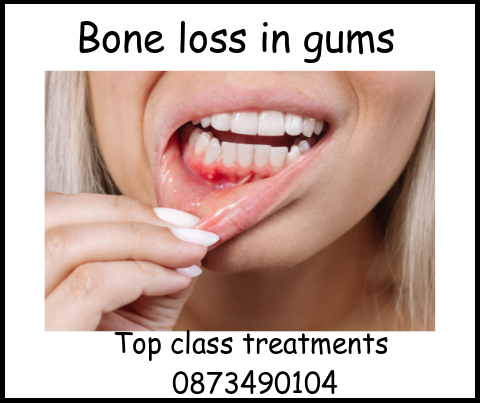Bone loss in gums
Bone loss in gums is quite serious and could become crucial to the success or failure of dental implants.
The aging process has an impact on bone loss in gums, there are other factors, many are under our control.

Let’s have a closer look at what are the causes of bone loss, how it affects dental implantation, and what is the treatment.
If you are experiencing bone loss in gums and need an opinion on treatment including the cost……
Call Fintan on 0873490104 for a free xray and bone loss in gums consultation with our experienced Hungarian Dentists in Wexford.
Causes of bone loss gums
Bone loss otherwise known as alveolar bone loss has a number of causes:
- Periodontal disease: Is mainly the cause of loss in the bone. The surrounding gums and bone around the teeth become infected. This is classed as a disease and causes bacteria to release unhealthy toxins that trigger an inflammation. The inflammation causes the bone to detoriate and lose density.
- Genetics: Bone loss can run in families, where genetics or variations of can leave a person susceptible to bone loss development.
- Oral hygiene: Not paying attention to oral hygiene allows plaque to gather on teeth and gums. Plaque if not treated can lead to gum disease, that in turn causes inflammation and in the end bone loss in gums.
- Smoking: Smoking, alcohol or tobacco use is closely linked to disease in the gums and loss of bone. Smoking affects blood vessels that supply blood flow to your gums. This will weaken the body’s immune system and it’s responses to infection. The healing process is impaired contributing to bone loss.
- Medications: Certain medications come with side effects. For example, abti-osteoporosis drugs, immunosuppressants, and anti-convulsants may have side effects that contribute to bone loss in gums.
- Chronic illness: Chronic illness that are systemic can impact on the health of the jawbone. Conditions such as osteoporosis, diabetes, or rheumatoid arthritis. These types of systemic diseases affect the immune system. Inflammation takes over and slows the body’s ability to maintain and repair the structure of the bone in the oral cavity.
- Changes in hormones: Fluctuations in hormones or changes for example during puberty, pregnancy, or the dreaded menopause
- Gum disease can have an effect on the gums. The change makes the gums become more sensitive to bacteria and irritants. The result is inflammation causing bone loss in gums.
Call Fintan on 0873490104 for a free xray and bone loss in gums consultation with our experienced Hungarian Dentists in Wexford.
How does bone loss affect the success of dental implants?
Bone loss can significantly impact the success of dental implants.
When a patient experiences bone loss in the jaw, it can make it challenging for the implant to properly fuse with the bone through osseointegration.
Insufficient bone density and volume can lead to implant failure, as there may not be enough support for the implant to remain stable in the long term.
It is essential for dentists to assess the bone quality and quantity before proceeding with implant placement.
Additional procedures such as bone grafting may be necessary to ensure the success of the implant treatment.
Regular maintenance and preventive care are also crucial in managing bone loss around dental implants to preserve the overall oral health and longevity of the implant.

Bone loss gums treatment
Treatment for bone loss in gums, also known as periodontal bone loss, typically involves a multi-faceted approach.
Bone loss gums treatment is aimed at addressing the underlying causes and preventing further deterioration.
Here are some common treatments for bone loss in gums:
1. **Scaling and Root Planing**: This deep cleaning procedure removes plaque and tartar from below the gumline, helping to eliminate bacteria that contribute to bone loss.
2. **Antibiotics**: In some cases, antibiotics may be prescribed to help combat infection and reduce inflammation in the gums.
3. **Bone Grafting**: This surgical procedure involves adding synthetic or natural bone material to the affected area to help promote new bone growth and restore lost bone.
4. **Guided Tissue Regeneration**: This technique involves using membranes or tissue-stimulating proteins to encourage the regeneration of bone and gum tissue.
5. **Laser Therapy**: Laser treatment can help remove bacteria and infected tissue from periodontal pockets, promoting healing and regeneration of the bone.
6. **Good Oral Hygiene Practices**: Brushing and flossing regularly, along with using an antiseptic mouthwash, can help prevent further it happening and maintain gum health.
7. **Regular Dental Check-ups**: Scheduling regular visits to your dentist for professional cleanings and check-ups is crucial for monitoring the progress of treatment and addressing any issues early on.

It’s important to consult with a dental professional to determine the most appropriate treatment plan based on the severity and your individual needs.
Early intervention and proper maintenance are key to effectively managing this serious condition in the gums.
Conclusion
In conclusion, bone loss in the gums is a serious condition that can lead to tooth loss if left untreated.
Maintaining good oral hygiene practices, regular dental check-ups, and addressing any risk factors can help prevent or manage the condition.
Read the lowest price for dental implants.
References
https://www.ncbi.nlm.nih.gov/pmc/articles/PMC3536461/

